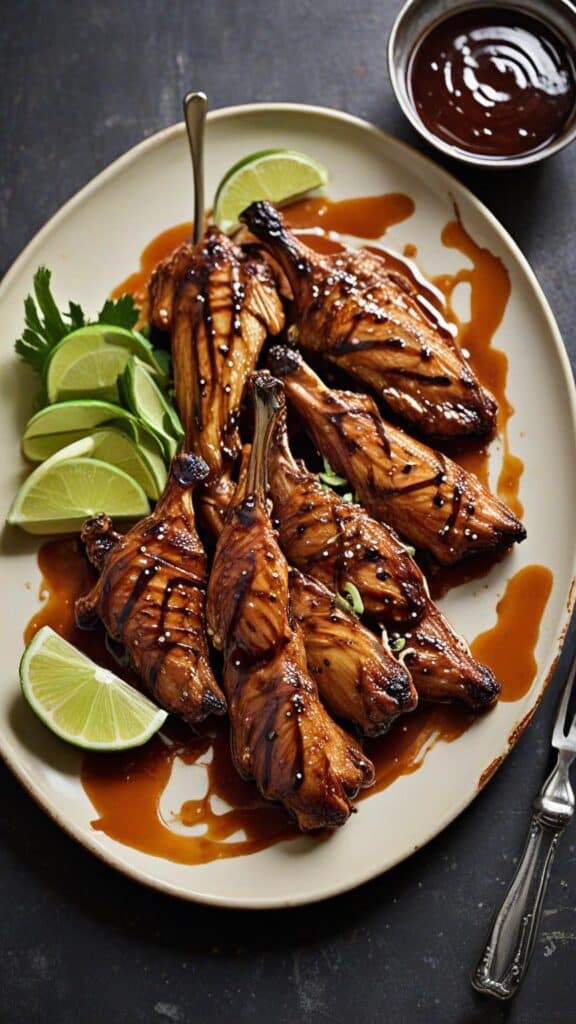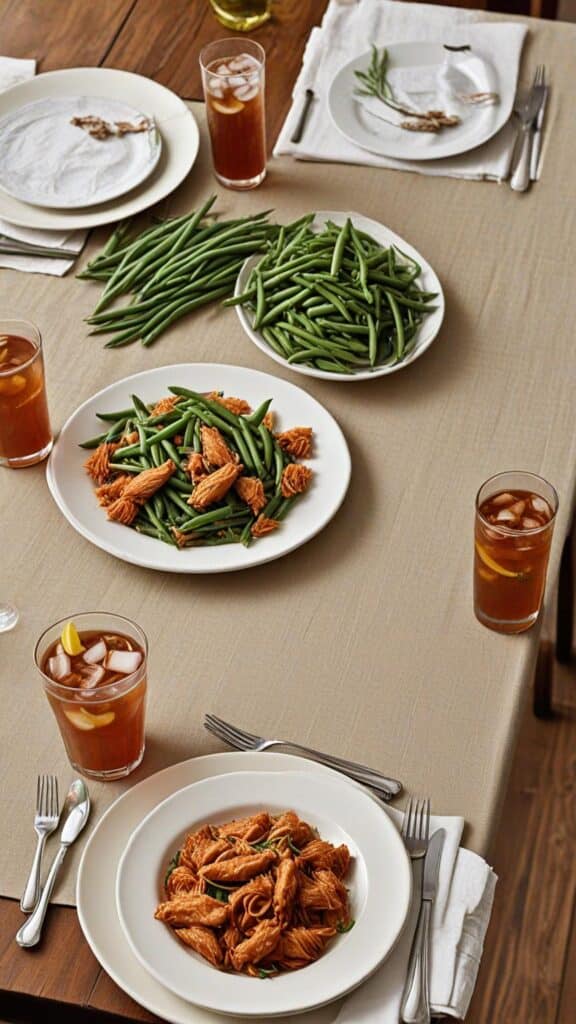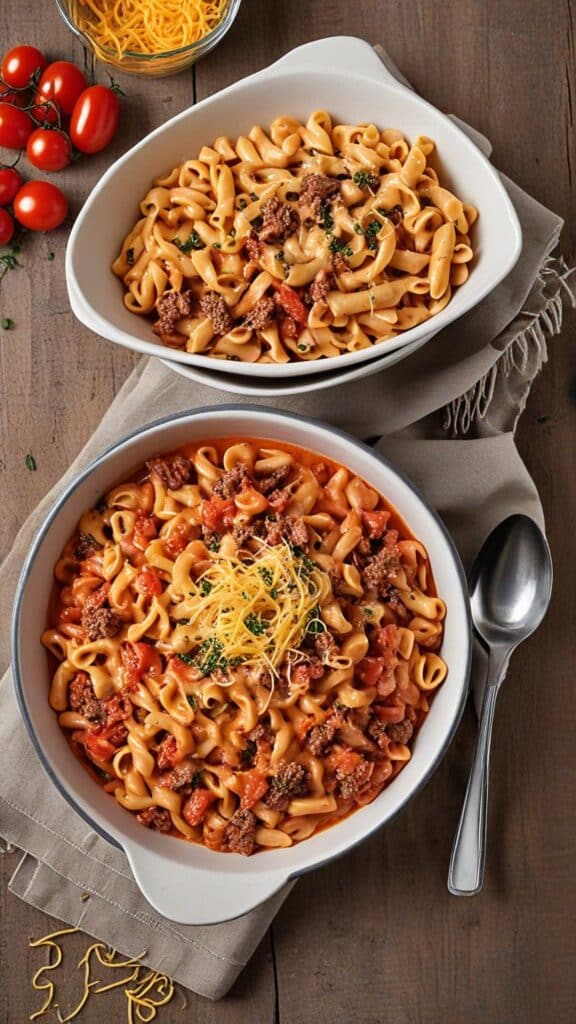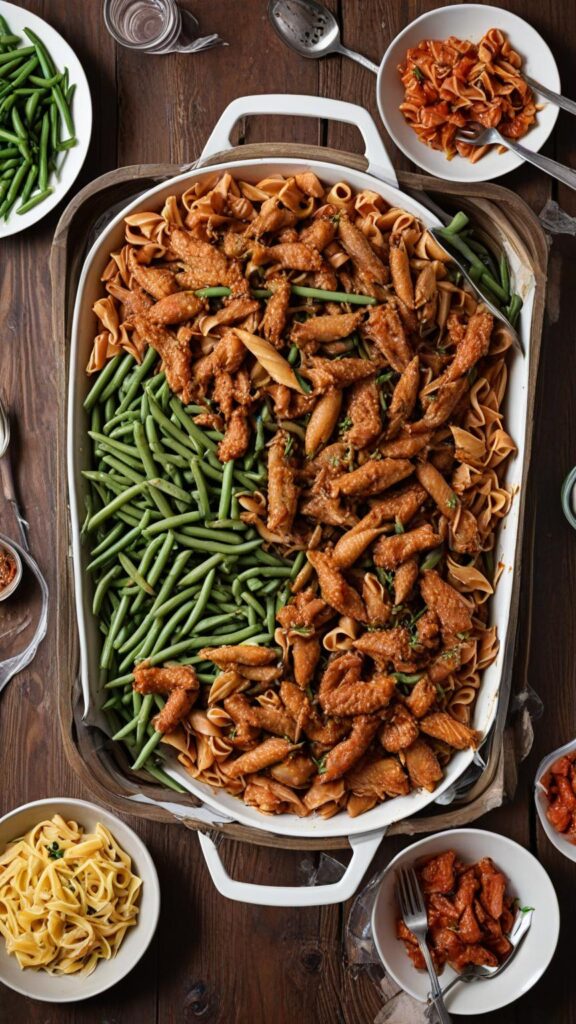I still remember the first time I saw these three dishes come together at my cousin’s backyard cookout in Memphis. The sight was almost comical—traditional Jamaican jerk wings sharing a plate with creamy Rotel pasta and simple Southern green beans. But that first bite? Pure culinary revelation. It shouldn’t of worked, but it did, magnificently.
This unlikely trio represents one of those beautiful culinary accidents that happen when cultural boundaries blur in American kitchens. The spicy, complex heat of Caribbean jerk seasoning balances perfectly against the creamy richness of Rotel pasta, while the clean simplicity of well-prepared green beans cuts through both, creating a surprisingly cohesive meal.
Jerk Wings: Caribbean Heat with a Purpose
Ingredients & Substitutions
- 3 pounds chicken wings, separated at joints, tips removed
- 1/4 cup fresh lime juice (about 2-3 limes)
- 1 tablespoon brown sugar (coconut sugar works as an excellent alternative)
- 2 tablespoons neutral oil like avocado or canola
- 6-8 green onions, roughly chopped
- 2-3 Scotch bonnet peppers, seeded (habaneros are a decent substitute, but less fruity)
- 4 cloves garlic
- 2 tablespoons fresh thyme leaves (or 2 teaspoons dried)
- 1 tablespoon fresh ginger, grated
- 1 tablespoon allspice berries, ground (pre-ground works but lacks punch)
- 1 teaspoon cinnamon
- 1/2 teaspoon nutmeg, freshly grated if possible
- 2 teaspoons black pepper
- 1 tablespoon soy sauce (coconut aminos for gluten-free)
- 1 teaspoon salt (or to taste)
Don’t even think about using pre-made jerk seasoning for this recipe—we’re talkin about the real deal here. The soul of jerk seasoning lies in that perfect balance of allspice, thyme, and Scotch bonnet heat. If you absolutley need to make substitutions, the most important element to preserve is that distinctive allspice flavor—it’s what distinguishes true jerk from any random spicy chicken.
Step-by-Step Instructions
- Prepare the marinade: Combine all ingredients except chicken in a food processor or blender. Pulse until you get a thick, slightly chunky paste. Some folks like it smoother, but I prefer keeping some texture—you want those little bits of green onion and pepper to caramelize on the grill.
- Marinate the wings: Place wings in a large zip-top bag or container and pour marinade over them. Make sure each wing gets thoroughly coated. Now here’s the secret most recipes don’t tell ya—score the meatiest parts of the wings with small cuts to help that marinade penetrate deeper. Refrigerate at least 6 hours, preferably overnight. Twenty-four hours ain’t too long if you’ve got the patience.
- Prepare for cooking: Remove wings from refrigerator about 30 minutes before cooking to take the chill off. This ensures more even cooking. If you’ve been marinating in a bag, transfer wings to a sheet pan, scraping excess marinade over them.
- Cooking options:
- Traditional grill method: Prepare a two-zone fire with medium-high heat on one side. Start wings on the cooler side for 15-20 minutes, turning occasionally, then move to direct heat to crisp up the skin (about 5-7 minutes per side).
- Oven method: Preheat to 425°F. Arrange wings on a wire rack set over a baking sheet. Bake for 45-50 minutes, turning halfway.
- Air fryer method: Cook at 380°F for 25 minutes, turning halfway. For final few minutes, increase temperature to 400°F for extra crispness.
- Finishing touch: For extra flavor, brush wings with any remaining marinade during the last few minutes of cooking (but only if you bring that marinade to a boil first for food safety). Rest the wings for 5 minutes before serving—trust me, this makes a difference in juiciness.
The most common mistake with jerk wings is not getting the heat right. Too hot and the sugars burn before the chicken cooks; too cool and you’ll never develop that gorgeous caramelization that makes jerk wings irresistible. For a milder version, reduce the Scotch bonnets to one, but don’t eliminate them entirely—the fruity flavor they provide is essential.
Cooking Techniques & Science
The magic of jerk cooking traces back to Jamaica’s Maroons, who developed this technique of spicing and slow-cooking meat over pimento wood. The combination of slow cooking followed by a final sear creates what food scientists call the Maillard reaction—that beautiful browning that creates hundreds of new flavor compounds.

Why the two-stage cooking process? The initial indirect heat gently cooks the protein while allowing the sugars and complex compounds in the marinade to slowly transform. The final higher-heat stage creates caramelization and those crispy, flavor-packed edges that make your taste buds dance.
Traditional jerk is cooked over pimento wood (from the same tree that produces allspice berries). If you’re feeling ambitious, add a few soaked allspice berries to your charcoal, or use a little allspice wood smoking chips. It makes a subtle but noticable difference in authenticity.
Rotel Pasta: Southern Comfort with a Kick
Ingredients & Substitutions
- 1 pound short pasta (shells, cavatappi, or rotini work best)
- 1 pound ground beef (80/20 for best flavor, or substitute ground turkey)
- 1 medium onion, finely diced
- 2 cloves garlic, minced
- 2 cans (10 oz each) Rotel diced tomatoes and green chilies (original or hot)
- 8 oz cream cheese, cubed and softened
- 8 oz Velveeta cheese, cubed (yes, Velveeta—we’ll discuss alternatives, but trust me here)
- 1/2 cup heavy cream
- 1 teaspoon smoked paprika
- 1/2 teaspoon cumin
- Salt and pepper to taste
- 2 green onions, thinly sliced (for garnish)
The controversial ingredient here is obviously Velveeta. While food snobs might turn up their noses, it’s smooth-melting properties are exactly what gives this dish its signature creaminess. If your putting on airs, substitute with 4 oz American cheese plus 4 oz sharp cheddar, but the texture won’t be quite the same.
For a vegetarian version, substitute the beef with impossible meat or a mixture of finely chopped mushrooms and walnuts sautéed with a dash of soy sauce for umami depth.
Step-by-Step Instructions
- Cook the pasta: Bring a large pot of salted water to a boil. Cook pasta 1 minute less than package directions for al dente. Before draining, reserve 1/2 cup of pasta water. This starchy water is liquid gold for adjusting the sauce consistency later.
- Prepare the meat base: In a large skillet or Dutch oven, brown the ground beef over medium-high heat, breaking it into small pieces as it cooks. When it’s about halfway cooked through, add the diced onion and continue cooking until the beef is no longer pink and the onions are translucent. Add garlic and cook for another 30 seconds—no longer or it might burn and get bitter.
- Build the sauce: Drain excess fat if necessary, leaving about 1 tablespoon in the pan. Add both cans of Rotel tomatoes (with their liquid) and bring to a simmer. Stir in cream cheese and Velveeta, reducing heat to medium-low. Continue stirring until cheeses are completely melted and incorporated. The mixture should be bubbling lightly. Add heavy cream, paprika, and cumin, stirring to combine.
- Combine and finish: Add the drained pasta to the sauce, stirring gently to coat every piece. If sauce seems too thick, add reserved pasta water a little at a time until you reach your desired consistency. Season with salt and pepper to taste, though be careful with salt—the cheeses and Rotel already contribute significant sodium.
- Serve: Remove from heat and let stand for 3-5 minutes before serving. This allows the sauce to thicken slightly and cling better to the pasta. Garnish with sliced green onions.
The biggest mistake homecooks make with this dish is rushing the cheese-melting process. Go low and slow, friends. High heat will cause the proteins in the cheese to seize up, giving you a grainy texture instead of that luscious creamy sauce we’re after.
For variations, try adding a can of drained black beans, some thawed frozen corn, or even some crumbled bacon on top. For extra heat, add a diced jalapeño with the onions or use Hot Rotel.
Cooking Techniques & Science
Rotel pasta represents a beautiful example of American fusion cuisine, combining Italian pasta preparation with Tex-Mex flavors and Southern comfort food techniques. The dish relies on emulsification—the process of binding water and fat molecules together into a smooth, cohesive sauce.

The scientific brilliance behind using processed cheeses like Velveeta is their added sodium citrate, an emulsifying salt that prevents the proteins in the cheese from separating under heat. This gives you that silky-smooth texture that homemade mac and cheese often struggles to achieve.
The addition of Rotel—a Southern staple combining diced tomatoes and green chilies—brings acidity that balances the richness of the cheese while adding subtle heat. The tomatoes also contain natural glutamates that enhance the umami flavor of the beef and cheese.
Southern-Style Green Beans: Simple Perfection
Ingredients & Substitutions
- 2 pounds fresh green beans, ends trimmed
- 4 slices thick-cut bacon, diced (substitute smoked turkey wings for a healthier option)
- 1 small onion, diced
- 2 cloves garlic, minced
- 1 cup chicken broth (or vegetable broth)
- 1 tablespoon apple cider vinegar
- 1/4 teaspoon red pepper flakes (optional)
- Salt and black pepper to taste
Lets talk bean selection. While French haricots verts are wonderful in their own right, traditional Southern green beans call for the sturdier, wider variety sometimes labeled “Kentucky Wonder” or simply “pole beans.” These stand up better to the longer cooking time and absorb flavors more effectively.
For a vegetarian version, skip the bacon and use smoked salt or liquid smoke (just a few drops!) along with vegetable broth and a tablespoon of olive oil.
Step-by-Step Instructions
- Prep the beans: After trimming the ends, snap or cut longer beans into 2-inch pieces. Some folks insist on removing the strings that run along the sides of older beans, but I find most modern varieties don’t require this step unless they’re very mature.
- Build the flavor base: In a large, heavy-bottomed pot or Dutch oven, cook the diced bacon over medium heat until it renders its fat and begins to crisp, about 5-7 minutes. Don’t rush this step—properly rendered bacon provides the foundation of flavor. Add diced onion to the bacon and fat, cooking until translucent, about 3-4 minutes. Add garlic and red pepper flakes (if using) and cook for 30 seconds more.
- Cook the beans: Add green beans to the pot, stirring to coat with bacon fat. Pour in chicken broth—it should come about halfway up the beans, not completely cover them. Bring to a simmer, then reduce heat to low. Cover and cook for 20-30 minutes for tender-crisp beans, or 45-60 minutes for traditional soft Southern-style beans. This is a matter of regional and personal preference—neither is “wrong.”
- Finish with acid: In the last 5 minutes of cooking, add the apple cider vinegar and season with salt and pepper to taste. The vinegar brightens the rich flavors and balances the savory elements. Let the beans continue to simmer uncovered for the remaining time.
- Serve: These beans should be served with some of their cooking liquid, which will have developed into a flavorful pot likker (that’s “pot liquor” for you non-Southerners) that’s perfect for sopping up with cornbread.
A common mistake with Southern green beans is under-seasoning. These beans can handle more salt than you might think, as they absorb it during the long cooking process. Always taste before serving and adjust accordingly.
For variation, add a diced red bell pepper with the onion, or toss in a ham hock instead of bacon for even deeper flavor. A sprinkle of fresh herbs like thyme just before serving adds a nice contrast to the long-cooked flavors.
Cooking Techniques & Science
Southern green beans represent a cooking philosophy that stands in direct contrast to the quick-blanched, crisp vegetable preparations favored in many restaurant kitchens. This low-and-slow method allows the beans to absorb flavor while breaking down some of their tougher cellular structures.

The inclusion of bacon provides not just flavor but crucial fat-soluble compounds that infuse throughout the dish. The technique of building a flavor base—starting with rendered fat and aromatics—is fundamental to many cuisines around the world, from French mirepoix to Cajun trinity.
The addition of acid at the end serves an important culinary purpose: long-cooked vegetables can taste flat or one-dimensional, but a splash of vinegar reawakens the palate and brings balance to the dish. This technique of “finishing with acid” is one that professional chefs employ across countless preparations.
Serving & Pairing Suggestions
This meal offers a beautiful study in contrasts—spicy, creamy, and savory elements that each play off the others. Serve the trio together on a large platter, rather than mixing them, to allow each component to shine while providing diners the joy of creating their perfect bite.

For plating, try arranging the jerk wings in a circular pattern around a mound of the creamy Rotel pasta, with the green beans adding a pop of color alongside. A garnish of thinly sliced green onions adds freshness to the presentation.
Beverage pairings need to stand up to the bold flavors of the jerk seasoning while complementing the creamy pasta. A crisp, hoppy IPA works surprisingly well, as does a semi-sweet Riesling for wine drinkers. For non-alcoholic options, try a spicy ginger beer or tart lemonade—both help cleanse the palate between these distinct flavors.
For a complete meal, consider adding a simple side salad dressed with a light vinaigrette to balance the richness of the main dishes. A piece of cast iron skillet cornbread wouldn’t be out of place either—perfect for soaking up the various delicious sauces.
Conclusion
This unexpected combination of jerk wings, Rotel pasta, and Southern green beans represents the beautiful evolution of American cooking—where influences from the Caribbean, Southern tradition, and Tex-Mex flavors come together to create something greater than the sum of its parts.
The key to success is respecting each dish’s individual tradition while understanding how they complement each other. The jerk wings bring complex spice and heat, the Rotel pasta offers creamy richness with a touch of acidity, and the green beans provide a savory, smoky foundation that grounds the meal.
Don’t be afraid to adjust each component to your taste—perhaps dialing back the Scotch bonnets if extreme heat isn’t your thing, or cooking the green beans to your preferred tenderness. Cooking is about making food that brings you joy, not rigidly following rules.
Frequently Asked Questions?
Can I prepare any components of this meal ahead of time?
Absolutely! The jerk marinade can be made up to a week in advance and kept refrigerated. The wings themselves should be marinated at least 6 hours, but overnight is ideal. Both the Rotel pasta and green beans reheat beautifully, possibly tasting even better the next day as flavors continue to develop. Just add a splash of cream or milk when reheating the pasta to revive the sauce.
How can I adjust the heat level of these dishes?
For the jerk wings, the heat primarily comes from Scotch bonnet peppers. Reduce the quantity or substitute with milder peppers like jalapeños for less heat. For the Rotel pasta, choose mild Rotel tomatoes instead of original or hot. The green beans can be made completely mild by omitting the red pepper flakes.
What are some gluten-free adaptations for this meal?
The jerk wings are naturally gluten-free if you substitute coconut amines for soy sauce. For the Rotel pasta, simply use your favorite gluten-free pasta shape—corn and rice blends tend to hold up best in creamy sauces. The green beans are already gluten-free as written.
How do I know when the jerk wings are done cooking?
The safest method is using an instant-read thermometer inserted into the thickest part of the wing without touching bone. The internal temperature should reach 165°F (74°C). Without a thermometer, look for clear (not pink) juices when you pierce the thickest part, and make sure the skin is nicely caramelized with no raw-looking marinade.
Can I make a vegetarian version of this meal?
Yes! For the wings, try using the jerk marinade on extra-firm tofu, cauliflower “wings,” or seitan. For the pasta, substitute the ground beef with Impossible meat, diced mushrooms, or black beans. The green beans can be made with smoked salt or liquid smoke instead of bacon, along with a tablespoon of olive oil for richness.

Veronica is a passionate food enthusiast with over three years of experience in exploring and writing about diverse cuisines. Her expertise lies in reviewing restaurants, sharing creative recipes, and discovering the latest food trends. As the voice behind FoodieRecap.com, Anju brings fresh perspectives and culinary insights to her audience.
